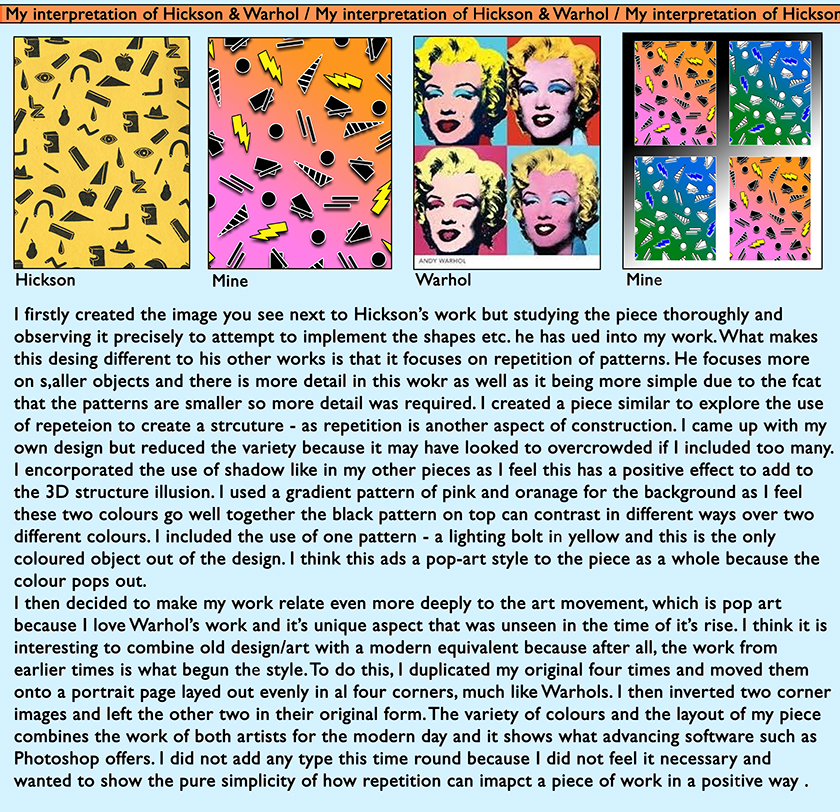
Category Archives: Research and analysis
Filters
Karl Blossfeldt, Photograph Analysis and Responses

Karl Blossfeldt was a German photographer born on June 13, 1865 and died on December 9, 1932 who worked predominantly in Berlin. He is famous for his his close-up photographs of plants and living things being inspired by nature and how plants grow leading to the idea of structure. He believed that ‘the plant must be valued as a totally artistic and architectural structure.’ He was appointed a teacher at the Institute of Royal Arts Museum in 1898 where he established an archive for his photographs. From here until his death, Blossfeldt’s works were used for teaching and were publicised in 1928 known as: Urformen der Kunst (Art Forms in Nature). Urformen der Kunst soon became a bestseller making Blossfeldt famous very quickly. Other artists were impressed by the abstract shapes created through the idea structure in nature which he successfully revealed. Walter Benjamin declared that Blossfeldt ‘has played his part in that great examination of the inventory of perception, which will have an unforeseeable effect on our conception of the world’, comparing him to the early pioneers of the New Objectivity movement.
Image Analysis

I love this photograph due the very simple layout presented through the white background and relatively harsh lighting. This helps to cause a strong contrast due to the shadows created from within the shapes and structures within the pine cone. Bright areas appear as a strong white, and the shadowed areas appear almost black. This is successful as it helps build a strong structure overall thanks to all these specific details and elements. Building on this, I like how the strong macro focus used allows us to differentiate, sharpen and exaggerate a lot of the dark/white tones. Also in terms of simplicity, the fact the photograph has been taken from a birds eye angle, this is significant because these simple techniques allow the viewer to focus more on the natural structure of the image. I particularly find interesting with the structure of the pine cone, showing layers at the bottom building up to the top. This is interesting because it shows how the pine cone is fundamentally reliant on the foundations of the body. This is true in many forms of structure and I believe that Karl Blossfeldt through taking this photograph has successfully highlighted. Interestingly, with the lack of color and strong emphasis on the sharp, intense textures generated from the pine cone gives the photograph quite a cold feel, causing there to be a feeling of lifelessness. This makes the viewer feel somewhat apprehensive due to the fact that pine cones are structures that are seen as part of nature. However due to the fact of how there appears to be quite a cold feeling coming from within the image, I can conclude that the structure in the image appears to cause a sense of hostility.

My Responses




Here are some images that I took during the shoot exploring my own style of taking photographs of natural structures in a studio. However I also incorporated into my work the inspiration I have felt after researching and analyzing Karl Blossfeldt’s work. I experimented with the use of flash but then I found the images looked slightly too piercing and that I had less control rather than with a studio light. Therefore I stuck with a white studio light, in quite a dim setting for the photographs with a white background. The photographs with the black background I used with natural light. Comparing them now I believe that the natural light tended to bring out the lighter parts of the photograph whereas the studio photographs, I had a much stronger ability to adjust the contrast to bled nicely with the shadows. In doing this, likewise with Karl Blossfeldt I could use this to focus well on contrast. I believe an increased contrast helps the object blend better with it’s background, surroundings and other elements of the photograph. Overall I believe my shoot was successful because I achieved a grounding in Karl Blossfeldt’s style whilst also developing some of my own to incorporate more of an emphasis on aperture and various angles whilst still enforcing the Karl Blossfeldt’s style of black and white. I believe I have captured the essence of structure effectively due to the choice of the actual objects. I wanted to ensure that I could do this bu taking my photographs using a macro setting to bring about the textures of the object and how these fibres make up the object itself as a structure.
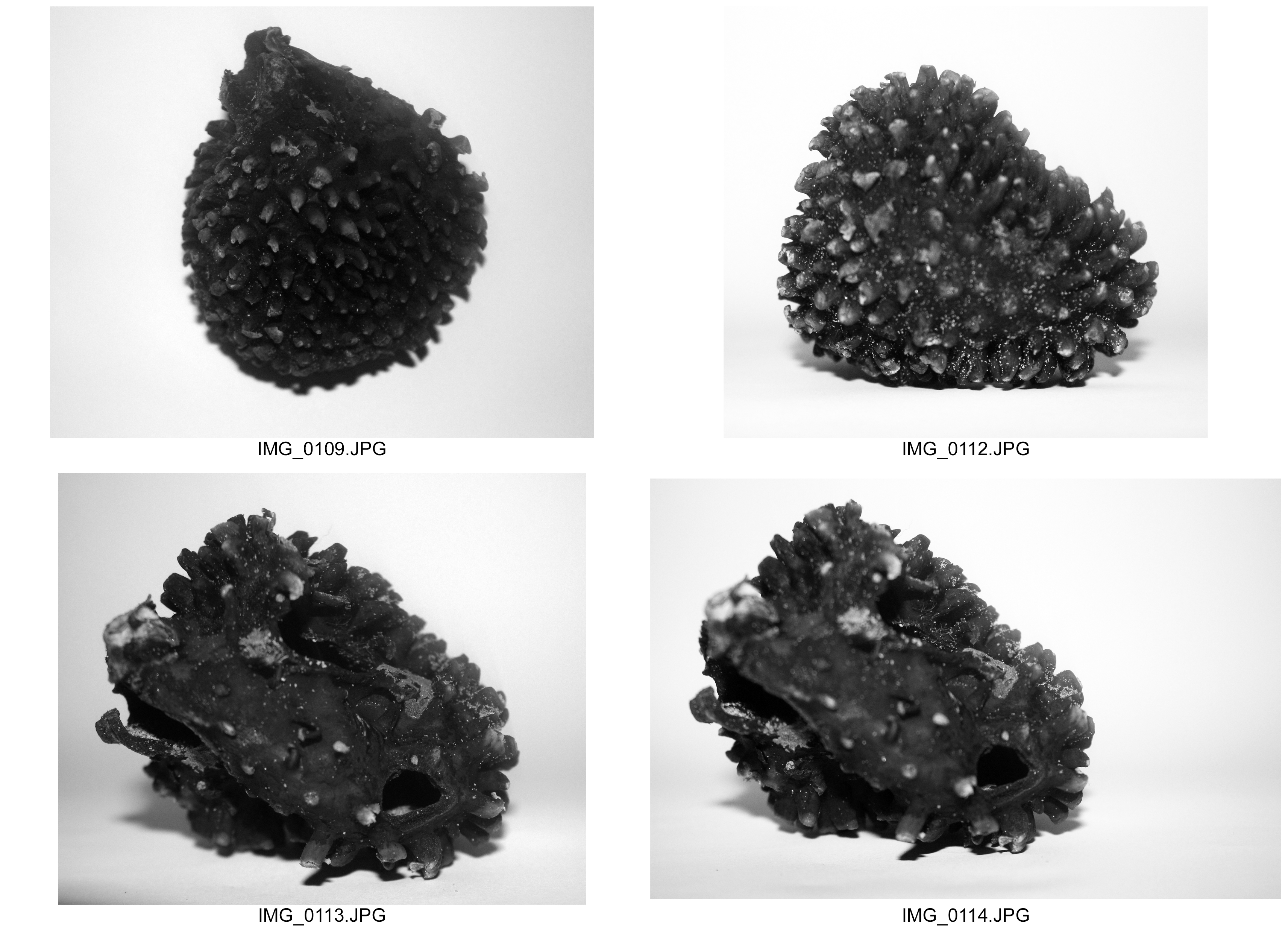






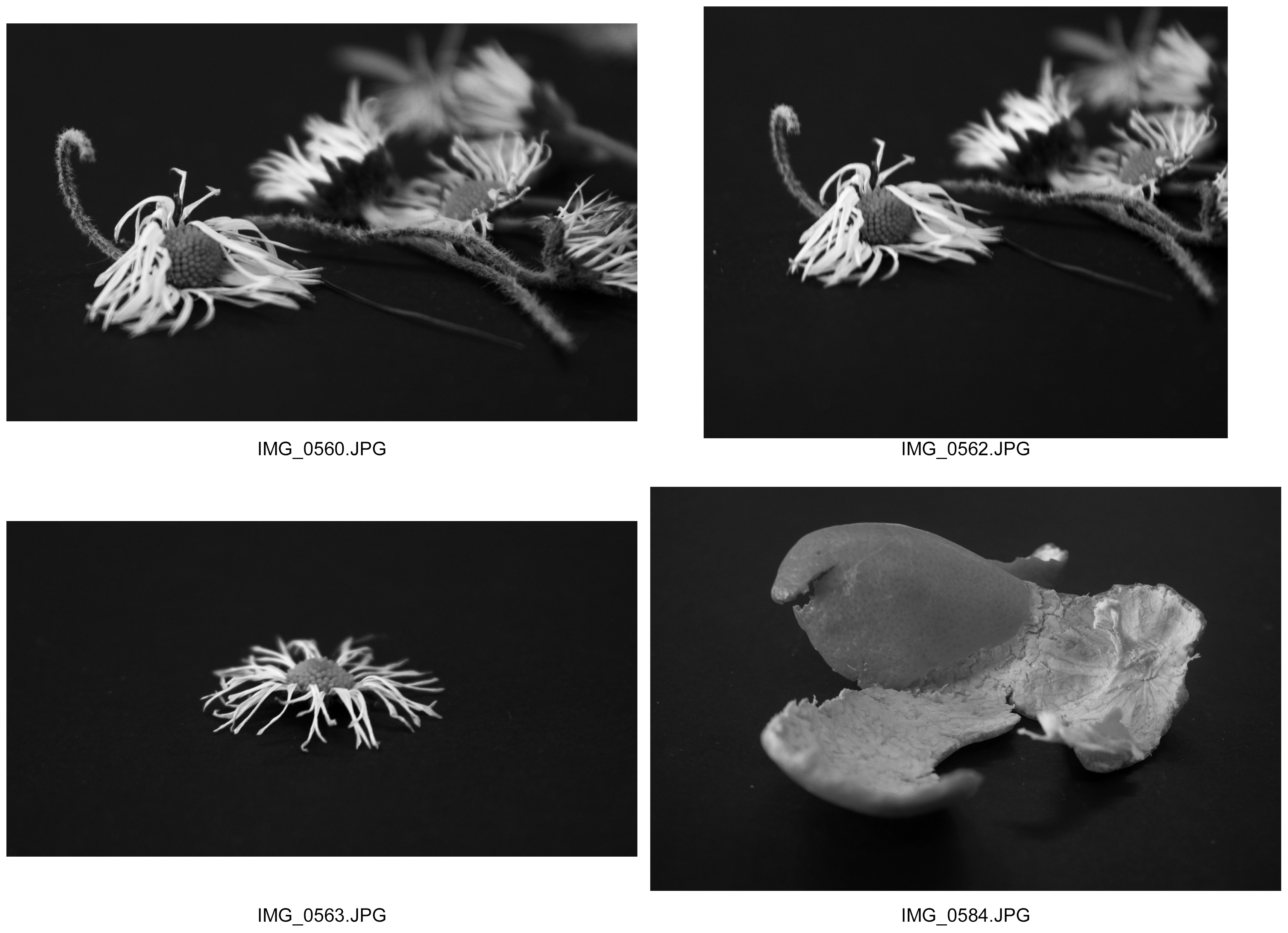






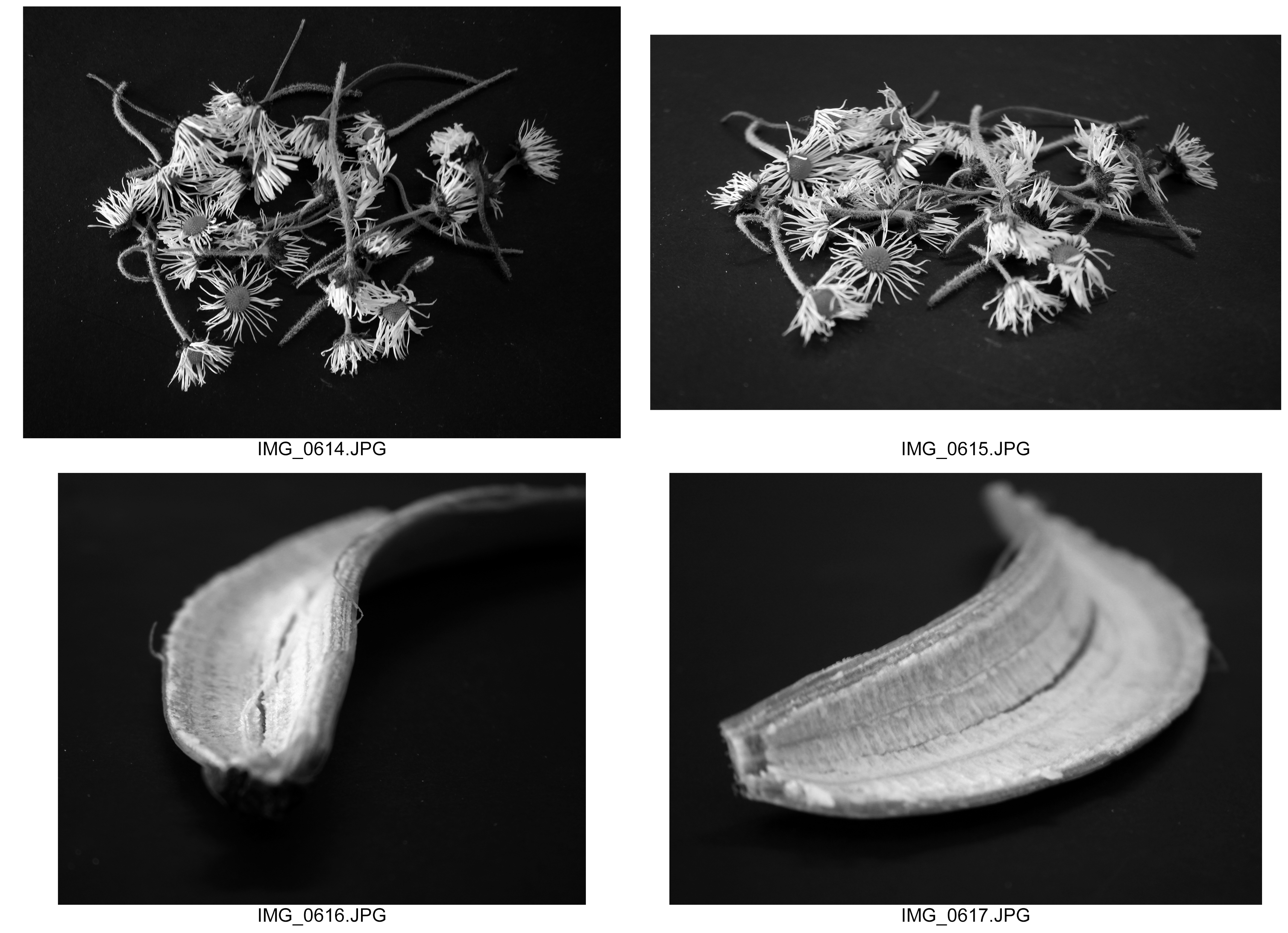

Best Images
I chose these as my final images because I believe that these show my own style, inspired and influenced by Karl Blossfeldt. In all of them I took them as a close up, attempting to show the structures of these objects as quite strong,bold and secure. I like how the aperture and use of the macro setting allows us to see tiny details of each object. I did this to show how every part of an object is important in terms of the structure and how everything has a separate part and role to play. Within each photograph using natural and artificial lighting, I ensured that I was in a bright environment to help the lens pick out the details in which I was hoping to capture. I also wanted to support this, through myself in terms of where I was placing each object and what angle they were positioned. I am confident that these photographs incorporate the theme of structure effectively and from here I would be interested to explore how black and white and aperture can be used to display further structure.





Andreas Feininger, Photograph Analysis and Responses

Andreas Bernhard Lyonel Feininger born December 27, 1906 – February 18, 1999, was an American photographer largely known for his black-and-white scenes of Manhattan and for his exploration of structures of natural objects. Feininger was born in Paris. In 1908 the family moved to Berlin and in 1919 to Weimar. Andreas left school at the age of 16 in 1922 to study at the Bauhaus graduating in 1925. After that he studied architecture at the Staatliche Bauschule Weimar (State Architectural College, Weimar) and after that at the Staatliche Bauschule Zerbst (where the Bauhaus moved to in 1926). During his architectural stidies Andreas developed an interest in photography and was given guidance by Bauhaus teacher Laszlo Moholy-Nagy. He gave up architecture and moved to Sweden in 1926 choosing to focus on photography. With the outbreak of WW2 in 1939, Feininger immigrated to the U.S. becoming a freelance photographer until joining Life magazine in 1943 till 1962. Feininger became famous for his photographs of New York, science and nature through work depicting bones, shells, plants, and minerals in the images which he profusively stressed their structure. Feininger wrote manuals about photography such as The Complete Photographer. Ralph Hatterley editor of the photography journal Infinity, described him as “one of the great architects who helped create photography as we know it today.”. He has won numerous awards. In 1966, the American Society of media Photographers (ASMP) awarded the Robert Leavitt Award. In 1991, the International Center of Photography awarded Feininger the Infinity Lifetime Achievement Award.
Image Analysis
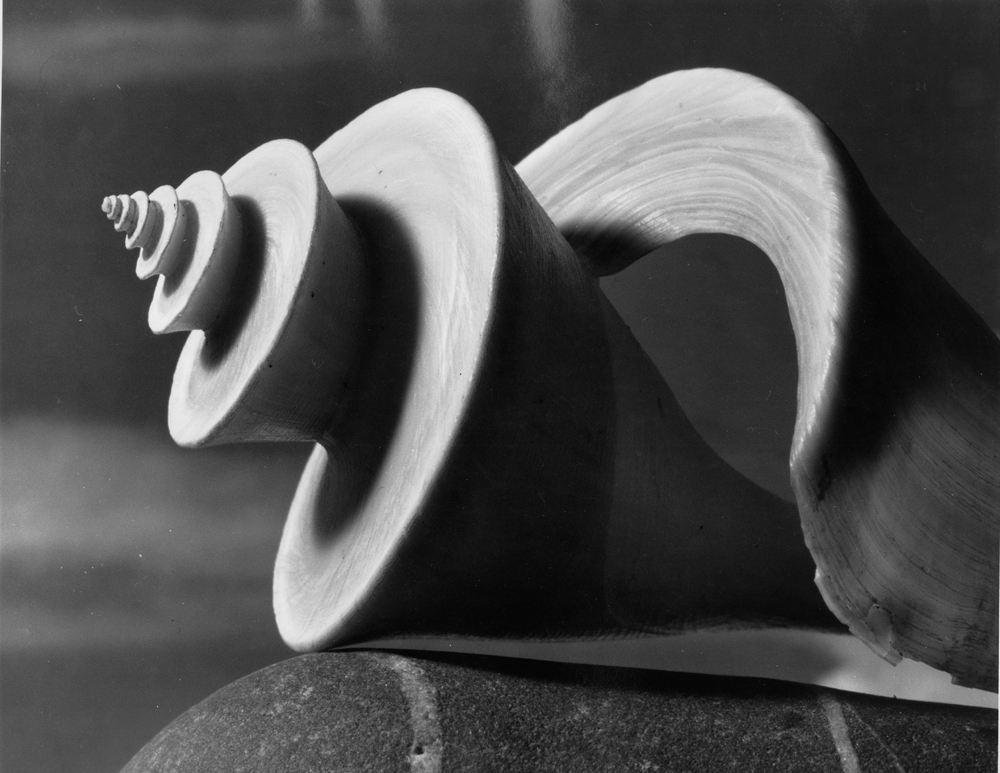
I love this photograph due to the beautiful texture and patterns caused by the natural structure. Why I particularly love natural structure is because of how the structure of the elements is free to go where it wants. I like how the angle is taken on a face on angle, allowing us to perceive the structure as slightly bigger than in reality. This has been exaggerated by the framing of the photograph through the fact that the structure doesn’t quite fit onto the frame. This is interesting to me because it strongly emphasizes the importance of structure within nature but also how it allows us to visualize how the structure of shells is formed by freely by nature. Andreas Feilinger I believe has successfully done this through the fact that the beautiful textures from within the shell are perfectly captured. For example, the photograph appears it has been taken from quite a distance with a strong zoom used. By doing this the photographer can achieve quite a shallow depth of field in the sense nearly all the shell is in focus. Interestingly, Andreas Feilinger has used a single light source, generating shadows around each curve that help illuminate the lighter parts. However there is a very smooth transition between dark and brighter tones to the right side of the shell, with very intricate textures being incorporated through the use of the macro setting. This displays a well developed exploration of the use of contrast that particularly strikes me as showing the structure as strong and solid. I believe I can develop my style as to incorporate techniques as using a low ISO with a relatively slow shutter speed to help capture the textures on the object with a single light source. I want to do this because a single light source involves an idea of simplicity showing just the structure for what it is and nothing else, and I believe by doing this, we can appreciate the hardened solid structure of the object for what it is.

What particularly strikes me about this photograph. The interesting shape and structure appears complex and also slightly mysterious to me. With the shape and structure appearing quite random, at first the photograph almost appears quite surreal. However after the viewer explores the photograph and examines it in further detail we can see how the structure is so very intricate. For example the dark background sets the environment to be quite dark and sets the mood as slightly tense. Then through the use of the low key lighting, the shell appears at the back to be brighter and expose grey tones and then further forward it appears brighter exposing further brighter tones of light. I believe this transition has been made smoothly through the shallow depth of field and aperture but also the angle of the lighting is positioned looking down and above towards the shell. Furthermore the framing of the photograph, similar to that of the previous photograph is slightly too big, isolating various parts of the photograph and highlighting the tip of the shell closest to the lens. On the other hand, it is slightly off center in terms of the rule of thirds, this is important because it highlights that the structure of the shell is holding up the other elements. Through this, the significance of structure is displayed as something that is essential in supporting the whole object which is the most important key aspect of structure. The photograph appears to have been slightly underexposed allowing the textures and light to appear smoother but also more subtle and allowing the well lit areas to be less harsh on the viewer. I like how Feininger has done this, and so for my shoot I will look to follow similar techniques however I would rather experiment with low key, chiaroscuro lighting. In doing this I wish to present my work as having a more dynamic representation of structure, by incorporating greater shadows adding depth to the structure of the object.
My Responses



Here are some more images I took from the shoot that was taken in a similar style to Andreas Feininger. This is somewhat similar to Karl Blossfeldt’s work in the sense that I took these photographs in a similar style to my response to his work. I looked at the theme of structure in a slightly different perception to Karl Blossfeldt’s work. In terms of the angles where Karl Blossfeldt takes his photographs form a bird’s eye view, Andreas Feirlinger is focused much more on face on angles that depict structure in a sense which I believe, is rather beautiful. I took these images in a brighter sharper light, complementing the sharper edges and textures of the objects themselves. In doing this, I placed a greater emphasis on more areas being illuminated and only fewer areas showing a stronger dark sense. I like how these photographs appear to have a direct link with Andreas Feilinger’s work. This shows natural structure effectively because of the slightly odd and random angles I took the photographs from, it compliments the same of the shapes and ranges of grey, white and dark scales. Likewise with Karl Blossfeldt’s work I took the photographs on am macro setting, I followed that technique up here. However whereas before I focused on particular areas with Blossfeldt’s responses, here I focused more on the actual object itself as a whole. This shows structure in a different light because whereas before I showed how individual elements of an object helped make up a structure, now I am showing all the elements together in one. This shows now how the structure is strong and secure and lees delicate and fragile where it almost appeared like that before. Interestingly, this strong and secure form of structure is very beautiful because of the consistent fineness and accuracy for the delicate areas and textures. This link shows that these miniature structures, when not joined together, appear random but when joined have a strong purpose of holding together the structure of the shell. So therefore despite the free and random shapes of these structures, what is significant is from what we can see from the photographs is how the role of the structure is very similar if not the same in each object.

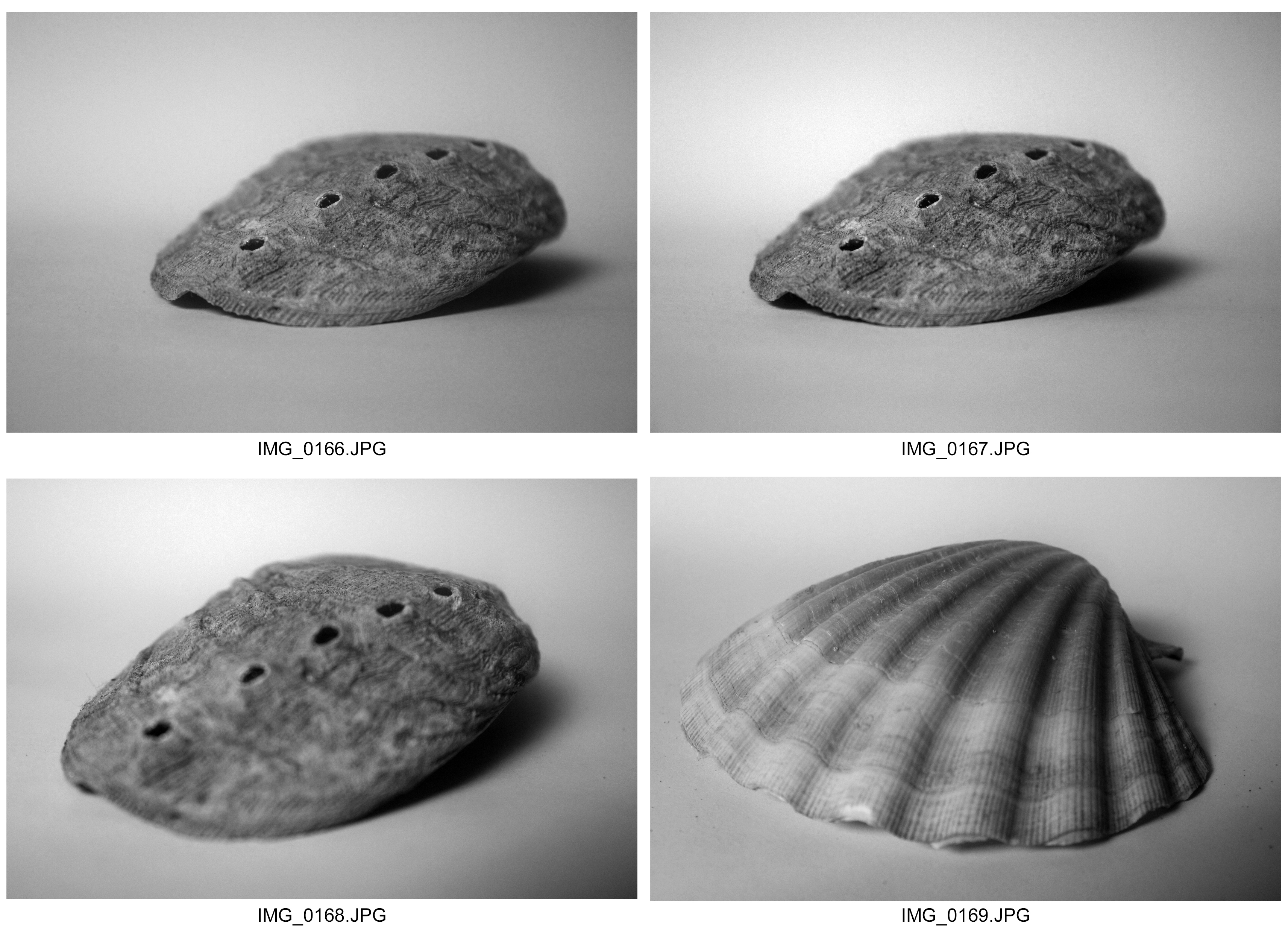

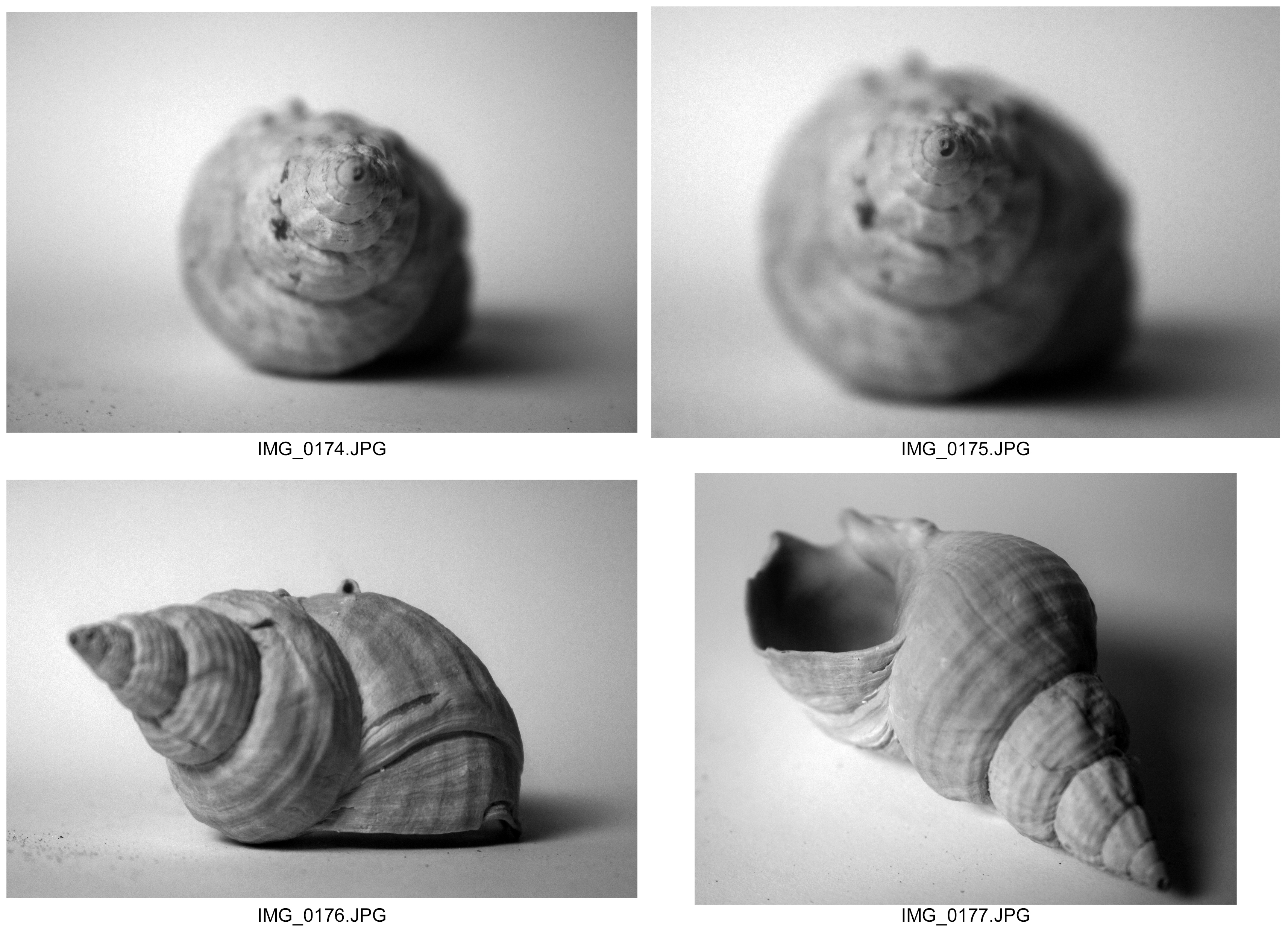
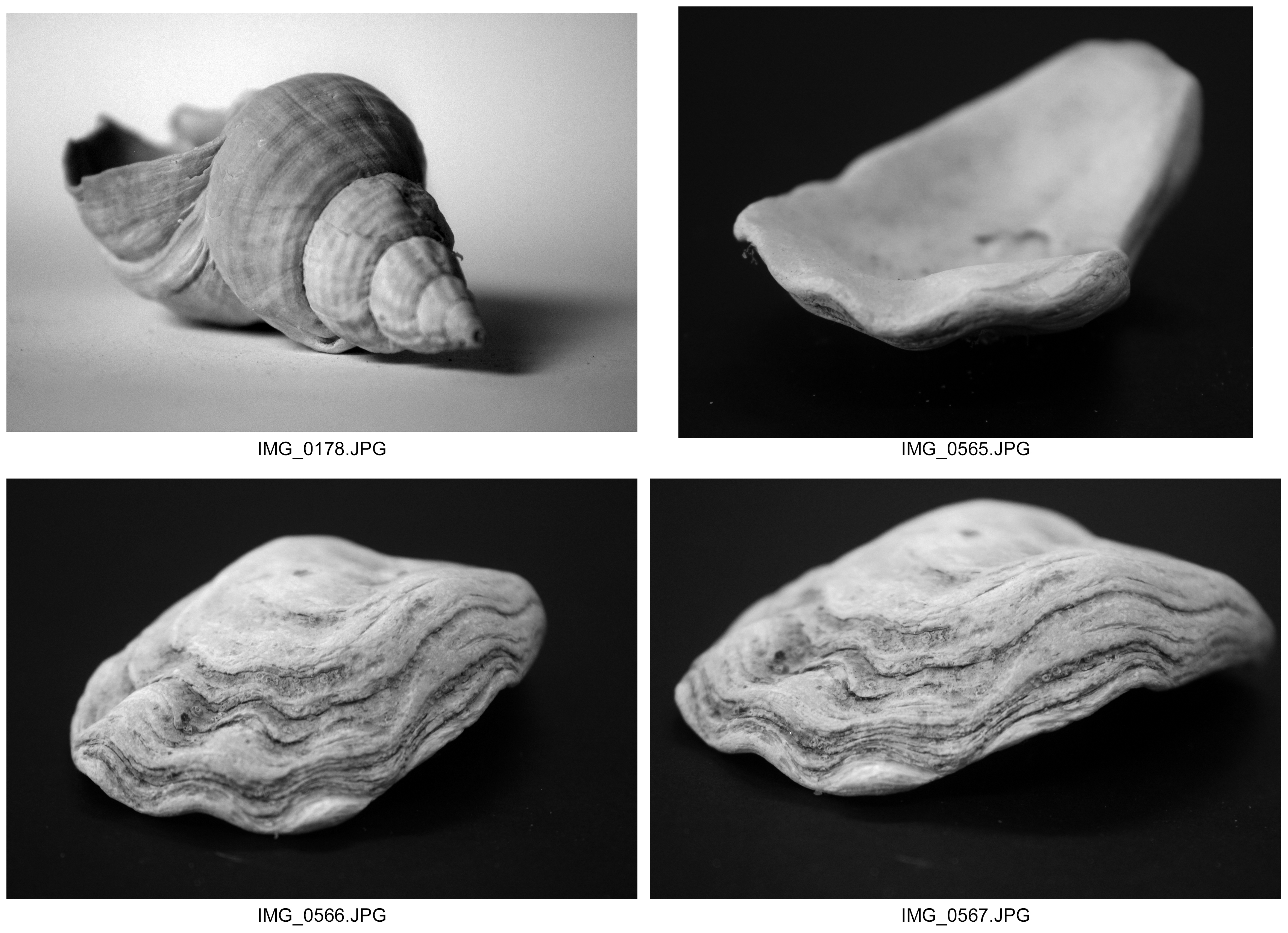



Best Images
I selected these as my best photographs because for me I love how similar they all are in terms of light source, texture and depth of field. However what sets them apart for me is how the shape of each object differs and through this how effectively they reflect light in the environment, create shadows and illuminating how sharp or smooth their textures are. For me I prefer to compare how each object responds and differs to this in this specific environment. I believe that the structure I have incorporated into these photographs is significant because it shows how the elements of natural structure are beautiful in the patterns they create, but also that the structure appears a little abstract. This fascinates me because, the question is: is how can something with such purpose, beauty and reason appear so abstract and almost random in its design? I believe that this question poses a challenge to me when exploring natural structure and through my photographs I hoped to have answered. For example random textures, shapes and perspective I believe show how despite the structure appears slightly random, it also helps make up the actual solid structure of the object itself. Natural structure for me follows a theme of freedom to it, I have captured in a well controlled environment. This selection of best images for me are important because they show that the structure between each object although holds the same role in all the other objects, each structure is coded to its specific object. This is significant because it adds to my idea of abstraction in the sense that each shell’s structure is using external features of shape, contrast and texture to hold an effect.








Artist No.1 / Clay Hickson / Comparison between Hickson and Warhol

Artist reference






Artist No.1 / Clay Hickson / My Interpretation of Clay Hickson
Here are some examples of designs I created on Photoshop based around the work of Clay Hickson, a graphic designer specializing in commercial advertising.
I have created these designs to build up my creativity for this project named ‘structure’. Understanding the simple use of line, shape and colour will benefit me in my main task for the project because these aspects are the formations of any structure – particularly for the most basic forms.

I really enjoy using Photoshop to create simple but meaningful and effective, stylish and modern designs because it gets my creativity going. I wished to show structure as a term, therefore used shapes to show structure. The word ‘geometric’ is useful to describe structure because they are shapes with personal features which define them as their own formation.
I also wanted to explore the use of shadows to create a three dimensional effect – something that I want to expand on in my short film inspired by Ill-Studio for the same purpose. However, I also believe that for what I want to achieve, shadows can act as deception to disguise two dimensional object and it deceive viewers especially with the use of a flat reflective surface.
I believe textures to be very important in creating an interesting structure, therefore added this into my creations below. I used grid paper as a background and to add depth. For the second design, I also used very acute dots as a pattern to put on the centre piece which is the circle to add texture. As well, on Photoshop, it is possible to add noise to images etc. and I really after noticing it in Hickson’s work because it gives it a vintage effect; I added noise in the shadows of each shape.
Typography isn’t a big feature in Hickson’s work apart from the odd type being seen in a couple of works, however, i really feel like it can add something more to the photo and require the audience to look your image with more care and focus. It can be used to explain what is happening or just as a decoration technique. I have used it for both and personally love the effect.
I am aware there is no aspect of personal photography in these designs, however they are only a starting point to seashore my skills on software such as Photoshop and they are the beginning of thoughts. I also wish to incorporate this into my edits and experiments of anything throughout the process. I have also created a version where there is image from previous projects noticeable in the edit.

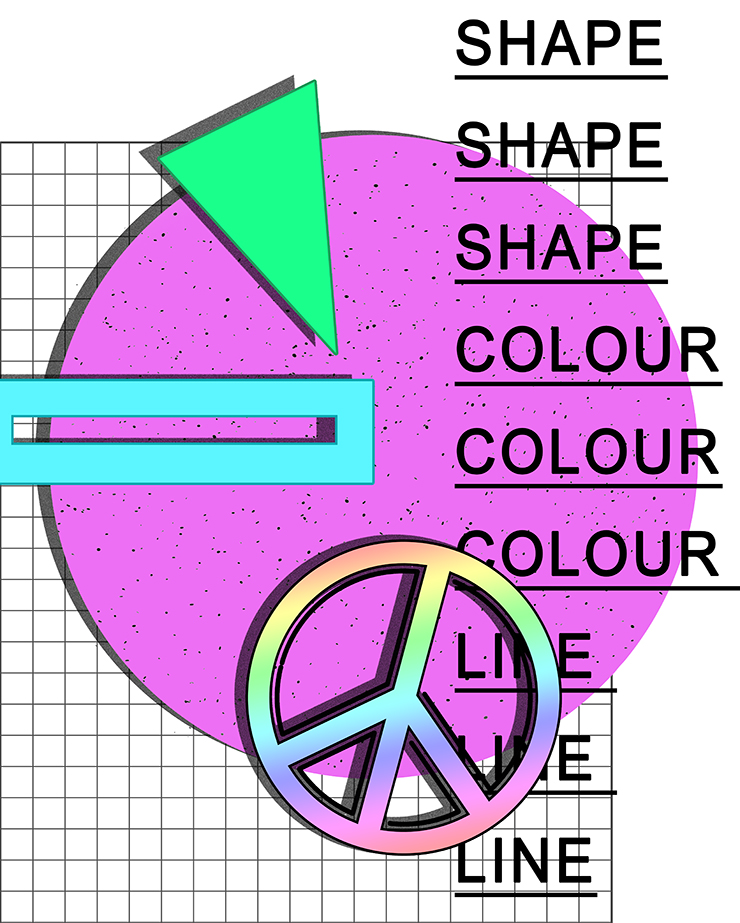
Previous work on Structure
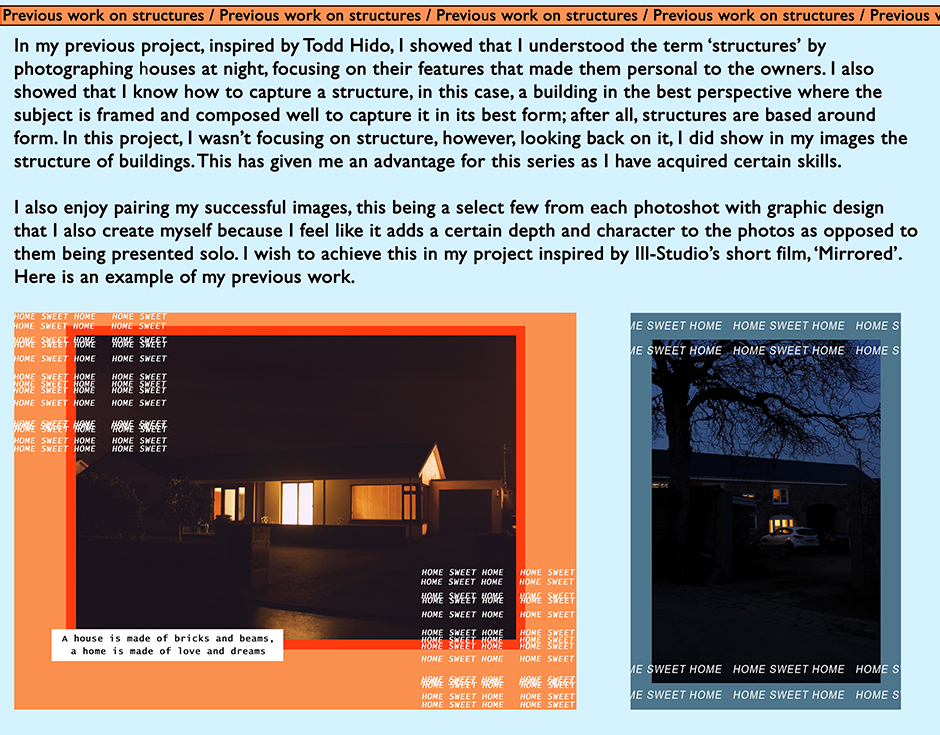

Photographers Photo Shoots
For my photo shoots I chose Miguel Ribeiro and Josephine Cardin as my inspiration as they where the two photographers that stood out for me when trying to find photographers. Even though both photographers are very different, with very different styles and techniques, they both caught my attention.
Josephine Cardin as her style of photographs is unrealistic and mysterious which brings in an element of how people make themselves feel and express themselves in ways that some people can’t explain why. Her work also in a way seems to be fairy tale like in a sense of it doesn’t seem to fit the perspectives of the human life.
Miguel Ribeiro as his work is very simple but very sophisticated in a way that it looks too easy to do. He expressed and shows the human body in its natural way of being and in a way that people can appreciate it both in a scientific way and in a time passing way (hobby).
Artist No.1 / Clay Hickson / Analysis

Artist No.1 / Clay Hickson / The Idea

